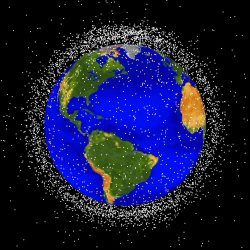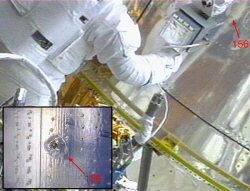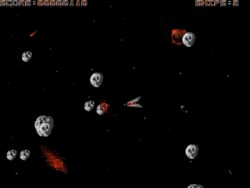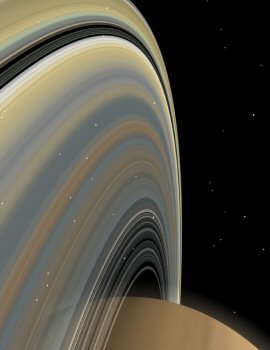Scientists able to track space junk in near Earth orbit. A lot of it!
 Imagine floating around inside the International Space Station (ISS), getting along swimmingly with your colleagues, when all of a sudden you all hear a loud "thud". The noise sounded like something hitting the station's exterior. "Who could that be?" you wonder, before feeling very silly. This event actually happened. The thud was believed to be a tiny piece of orbiting space debris, which had possibly broken away from a decommissioned satellite or the like. This event led to the fitting of a higher-frequency radar unit to one of the ground antennas to detect small but potentially deadly pieces of man-made space junk; enabling it to track objects between five and ten centimeters (2-4 inches) in size.
Imagine floating around inside the International Space Station (ISS), getting along swimmingly with your colleagues, when all of a sudden you all hear a loud "thud". The noise sounded like something hitting the station's exterior. "Who could that be?" you wonder, before feeling very silly. This event actually happened. The thud was believed to be a tiny piece of orbiting space debris, which had possibly broken away from a decommissioned satellite or the like. This event led to the fitting of a higher-frequency radar unit to one of the ground antennas to detect small but potentially deadly pieces of man-made space junk; enabling it to track objects between five and ten centimeters (2-4 inches) in size. With the increasing number of satellites, and who knows what else, being shot into space, the problem of space-junk is getting worse - fast. NASA says that along with naturally occurring meteoroids, our near-Earth space orbit has become so cluttered with man made debris that it poses a very real danger to future missions (which, of course, are also likely to leave behind their fair share of junk). It seems that when a satellite deteriorates, malfunctions or becomes obsolete, the boys at ground control just hit the off-switch and replace it with another, leaving the old one to continue aimlessly orbiting the Earth.
And it's not just decommissioned satellites. According to Australian Government astronomer, Dr. James Biggs, other types of debris have appeared over the years due to, well, our rather cavalier approach to space activities. Biggs says that extra-vehicular activity (EVA), repairs to spacecraft, nuclear testing and crude anti-satellite technology tested during the 80s and 90s have all contributed to the rocket casings, fairings, nuts and bolts, flecks of paint, gloves, tools and other potentially lethal bits of shrapnel currently orbiting the Earth.
Some environment projection studies carried out between 1991 and 2001 indicate that after accounting for future launch rates; "the debris populations at some altitudes in low Earth orbit (LEO) will become unstable. Collisions will take over as the dominant debris generation mechanism, and the debris generated will feed back to the environment and induce more collisions," according to NASA's rather dryly titled Orbital Debris Quarterly News. But it gets worse.
 A paper appearing in the journal Science earlier this year summarized research conducted by NASA over the years, and its findings make chilling reading for anyone contemplating a jaunt into orbit. "Currently more than 9000 objects, with a combined mass exceeding 5 million kilograms, are tracked by the U.S. Space Surveillance Network," said lead authors J. C. Liou and N. L. Johnson. The paper shows that these debris levels will remain constant up until 2055, after which time they will increase. In order to avoid various uncertainties, the study (obviously incorrectly) assumed a launch cut-off point from January 2005. But even with this imaginary cut-off date, the study found that: "Debris populations in this 'red zone' [900 to 1000 km altitude] will approximately triple in the next 200 years, leading to a factor-of-10 increase in collision probability. In reality, the future debris environment is likely to be worse than the study suggested, as satellites continue to be launched into space." Both NASA and the authors of the study recommend that a plan aimed at removing this space junk should be implemented as soon as possible.
A paper appearing in the journal Science earlier this year summarized research conducted by NASA over the years, and its findings make chilling reading for anyone contemplating a jaunt into orbit. "Currently more than 9000 objects, with a combined mass exceeding 5 million kilograms, are tracked by the U.S. Space Surveillance Network," said lead authors J. C. Liou and N. L. Johnson. The paper shows that these debris levels will remain constant up until 2055, after which time they will increase. In order to avoid various uncertainties, the study (obviously incorrectly) assumed a launch cut-off point from January 2005. But even with this imaginary cut-off date, the study found that: "Debris populations in this 'red zone' [900 to 1000 km altitude] will approximately triple in the next 200 years, leading to a factor-of-10 increase in collision probability. In reality, the future debris environment is likely to be worse than the study suggested, as satellites continue to be launched into space." Both NASA and the authors of the study recommend that a plan aimed at removing this space junk should be implemented as soon as possible.
If you are unsure as to how many satellites and other spacecraft currently exist up there (the ones we do know about, that is), then a visit to www.n2yo.com should be enlightening. The site is an amalgamation of Google Maps and satellite data that allows you to track the location of a large number of spacecraft. But you may be wondering that if there are so many bits and bobs floating around out there, why don't we hear of more collisions and space disasters? Is NASA overreacting? The answer is no, they are not, and the danger, especially to manned missions, is all too real.
 It's not so much the size of the debris that is of concern, but rather the velocity at which the debris travels. If one of these tiny bits of junk were to collide with a spacecraft the result could be anything from inconvenient to catastrophic. Of course, running headlong into a satellite coming from the opposite direction wouldn't be a barrel of laughs either, but it would also be a highly unlikely scenario. According to Dr. Biggs, the orbits of larger debris are relatively easy to track, and therefore easy to avoid. But just what size are we talking about here? Biggs says that debris measuring 5cm (2 inches) can be tracked at distances of thousands of kilometers into space, and once the orbit has been determined they are quite easy to avoid. So in regard to the recent Shuttle launch, the known orbits of debris could be factored in to their calculations, says Biggs. However, there have been occasions when NASA has had to adjust the Shuttle's flight path many times during a mission to avoid debris.
It's not so much the size of the debris that is of concern, but rather the velocity at which the debris travels. If one of these tiny bits of junk were to collide with a spacecraft the result could be anything from inconvenient to catastrophic. Of course, running headlong into a satellite coming from the opposite direction wouldn't be a barrel of laughs either, but it would also be a highly unlikely scenario. According to Dr. Biggs, the orbits of larger debris are relatively easy to track, and therefore easy to avoid. But just what size are we talking about here? Biggs says that debris measuring 5cm (2 inches) can be tracked at distances of thousands of kilometers into space, and once the orbit has been determined they are quite easy to avoid. So in regard to the recent Shuttle launch, the known orbits of debris could be factored in to their calculations, says Biggs. However, there have been occasions when NASA has had to adjust the Shuttle's flight path many times during a mission to avoid debris.
Biggs says "it's the stuff we don't know about" that presents the most danger, as he recalls how just a tiny fleck of paint was cause for concern during one of the earlier Shuttle missions. As an astronaut on board the aforementioned Shuttle flight, Sally Ride also remembers the incident. "About halfway through the flight there was a small pit in the window of the space shuttle and we didn't know what it was. An awful lot of analysis was done while we were in orbit to make sure that the strength of the window would sustain reentry. It did. We were all fine. But the analysis afterward showed that our window had been hit by an orbiting fleck of paint, and the relative velocities were enough that the paint actually made a small but visible gouge in the window," said Ride, during a lecture she gave at Stanford Center for International Security and Cooperation in 2002. Stories such as this highlight NASA's worry that as orbit zones become even more cluttered there is a greater chance of collision; and a greater likelihood that undetectable particles will be formed and jettisoned into new and deadly orbits.
 At present, NASA is working to avoid adding to the vast amount of space litter by implementing a strategy they call "Orbital Debris Mitigation." Some of the measures proposed include: "designing satellites to withstand impacts by small debris, and implementing operational procedures ranging from utilizing orbital regimes with less debris, adopting specific spacecraft altitudes, and even maneuvering to avoid collisions with debris." Biggs also suggests equipping satellites with enough power to send them back toward earth once they have expired. But this may involve coming up with innovative ways of transcending weight restrictions and, of course, the added cost. Maybe they should incorporate the satellite tracking system with the retro videogame Asteroids. That way, the online gaming community could make sure that any approaching space junk could be destroyed before inflicting damage on future missions.
At present, NASA is working to avoid adding to the vast amount of space litter by implementing a strategy they call "Orbital Debris Mitigation." Some of the measures proposed include: "designing satellites to withstand impacts by small debris, and implementing operational procedures ranging from utilizing orbital regimes with less debris, adopting specific spacecraft altitudes, and even maneuvering to avoid collisions with debris." Biggs also suggests equipping satellites with enough power to send them back toward earth once they have expired. But this may involve coming up with innovative ways of transcending weight restrictions and, of course, the added cost. Maybe they should incorporate the satellite tracking system with the retro videogame Asteroids. That way, the online gaming community could make sure that any approaching space junk could be destroyed before inflicting damage on future missions.
Check out some pics of space debris and the damage it causes: http://www.orbitaldebris.jsc.nasa.gov/photogallery/photogallery.html
New pictures of Saturn, breath taking
 As Cassini beams back a sequence of new images, NASA imaging team members are receiving yet more clues about the formation and structure of Saturn's G and E rings. The team has confirmed that a bright arc located on the inside edge of the G ring seems to be an established feature, which may be held in position by a nearby moon that also influences Neptune's rings. This latest series of images are of a resolution not previously seen, but the new clarity appears to raise more questions than it answers.
As Cassini beams back a sequence of new images, NASA imaging team members are receiving yet more clues about the formation and structure of Saturn's G and E rings. The team has confirmed that a bright arc located on the inside edge of the G ring seems to be an established feature, which may be held in position by a nearby moon that also influences Neptune's rings. This latest series of images are of a resolution not previously seen, but the new clarity appears to raise more questions than it answers.Viewed as a short film, Cassini's latest images show an arc of illuminated material winding its way around the inside edge of Saturn's G ring. First viewed during Cassini's orbit insertion, the G ring is a 4,400-mile wide band of icy dust particles that lies 16,800 miles beyond the F ring. The team had already seen the G ring's arc in 2005, but this latest viewing seems to confirm that the arc is a permanent fixture. "We have seen the arc a handful of times over the past year," said Dr. Matt Hedman, Cassini imaging team associate working at Cornell University in Ithaca, New York. "It always appears to be a few times brighter than the rest of the G ring and very tightly confined to a narrow strip along the inside edge of the 'normal' G ring."
The team thinks that the arc feature may have remained due to some resonant influence of the moon Mimas, which is also responsible for Neptune's ring arcs. "We've known since the days of Voyager that we had Jovian-type and Uranian-type rings within the rings of Saturn," said Cassini imaging team leader Dr. Carolyn Porco in Boulder, Colorado, who was the first to discover the dynamics of the Neptunian arcs based on Voyager's observations. "Now it appears that Saturn may be home to Neptunian-type rings as well. Saturn's rings have it all!"
The team is still unsure how the bright arc formed, but one hypothesis is that a cloud of fine particles formed after the collision of icy, meter-sized objects, which later came under the influence of Mimas. But this theory raises more questions than it answers, as it suggests that the main G ring could be the result of particles seeping from and drifting out from the arc.
The team also had some prior speculations confirmed in regard to Saturn's E ring. Using enhanced, high-resolution imaging, the team showed that there was indeed a relationship between Enceladus's south polar geysers and Saturn's E ring particles. Cassini was positioned in relation to Saturn so that the ring was viewed edge-on, giving the ring a double-banded effect. This effect can occur when the particles circling Saturn are on inclined and restricted orbits; an effect also associated with Jupiter's gossamer ring. The reason for this special circumstance is not exactly known, but it could be the result of two factors. The first hypothesis is that the restricted particle orbits may be determined by the velocity at which they are ejected out of Enceladus. The second possibility is that while particles may begin with a large range of orbits, those orbiting very close to the ring plane get gravitationally scattered and removed from that region.
The team hopes that more clues will be forthcoming after the next imaging run of Saturn's G and E rings. Further studies will incorporate observational and dynamical models that should explain many of the questions raised by the current images. "We'll want images from a few other vantage points to be sure of the structure, and then we can test several models to see why these ring particles end up in such a distinct configuration," said Cassini imaging team member Dr. Joseph Burns, also of Cornell.
No comments:
Post a Comment